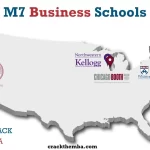What are STEM MBA Programs in the US (2025): Compare Schools, Costs & Career Outcomes
What if we told you there’s an MBA that gives you top-tier business skills and a three-year runway to launch your career in the United States? Welcome to the world of the STEM-designated MBA, a degree that blends business leadership with analytical, technological, and data-driven expertise.
Over the last few years, the STEM MBA in the US has quietly become the go-to choice for ambitious professionals, especially international students, looking to future-proof their careers. Whether you’re eyeing a role in consulting, tech, finance, or product management, a STEM MBA doesn’t just open doors; it keeps them open longer thanks to the extended work visa (OPT) it comes with.
But this isn’t just about immigration. With AI, data science, and digital transformation reshaping every industry, employers are seeking MBA grads who can speak both the language of strategy and technology. That’s exactly what a STEM MBA delivers — and why it’s one of the smartest degrees you can earn today.
In this guide, we’ll break down everything you need to know about STEM MBA programs in the US — from how they work and who they’re for, to the top schools offering them and why they’re worth it.
Let’s dive in.

What is a STEM MBA?
Let’s clear up the buzz. A STEM MBA is not some obscure tech degree wrapped in a business label. Instead, STEM MBA is a regular MBA program that’s been officially designated as STEM (Science, Technology, Engineering, and Math) by the US Department of Homeland Security.
But here’s the twist: not every MBA qualifies. Only programs that are heavily analytical, data-driven, or quantitative — think business analytics, operations, finance, supply chain, and even certain marketing tracks — get the coveted STEM designation.
In technical terms, these programs fall under specific CIP codes (Classification of Instructional Programs). Don’t worry, you don’t need to memorize those. What matters is this – if your MBA falls under one of these approved codes, you’re eligible for the 24-month OPT extension on top of the standard 12 months, which gives you up to 3 years to work in the US after graduation.
So, essentially, a STEM MBA gives you:
- A strong mix of business + tech skills
- More time to work in the US
- A competitive edge in data-savvy roles across industries
Whether your goal is to lead products at Google, crack cases at McKinsey, or drive strategy in fintech on Wall Street, a STEM-designated MBA gives your resume the edge it needs.
And yes, the good news is, many top business schools in the US now offer STEM MBA options, either for the full program or specific tracks within it.
Benefits of a STEM MBA in the US
So, what’s all the hype about? Why is everyone, especially international applicants, chasing that little four-letter word next to their MBA program?
Here’s the deal: a STEM MBA isn’t just a fancy label. It comes with some serious perks that can change the trajectory of your career (and life) in the US. Let’s break it down:
3 Years of Work Authorization in the US
This is the big one.
If you graduate from a regular MBA program, you get 12 months of Optional Practical Training (OPT) to work in the US. But if your MBA is STEM-designated, you can apply for a 24-month OPT extension, giving you up to 36 months of work authorization.
That’s three full years to gain experience, get sponsored, and build a solid career foundation. No more racing against the clock to secure an H-1B right after graduation.
In-Demand Skills That Employers Want
STEM MBAs are built for the modern economy. We’re talking:
- Data analysis
- Financial modeling
- Supply chain optimization
- Product strategy
- AI & machine learning in business
Companies love hiring MBAs who can do more than just PowerPoint and pitches. They want people who understand data, tech, and strategy. That’s you.
More Time = More Opportunities
The 3-year OPT isn’t just about staying longer. It means:
- More chances to land a job in the US
- A better shot at multiple H-1B lottery cycles
- Time to pivot roles or industries if your first job isn’t the perfect fit
Think of it as career flexibility on steroids.
Future-Proofing Your Career
The business world is evolving quickly. Roles like product manager, data-driven consultant, tech investor, or digital transformation lead aren’t going away anytime soon.
A STEM MBA arms you with the skills to stay relevant, adapt quickly, and lead with both business acumen and tech fluency.
In Essence
At its core, a STEM MBA is your gateway to extended time in the US, greater career opportunities, and a future-proof path in today’s competitive market.
So let’s get to the good part: the top STEM MBA programs in the US you need to know about
Top STEM MBA Programs in the US (2025 Edition)
From coast to coast, many of the top business schools in the US have introduced full or partial STEM-designated MBA options. Here’s a curated list of the best ones to consider in 2025 — especially if you’re looking to combine business leadership with long-term work potential in the US.
| Business School | Location | STEM Designation | Program Duration | OPT Eligibility | Avg. GMAT | Tuition Fees (USD) | Placement Rate |
|---|---|---|---|---|---|---|---|
| University of Chicago Booth | Chicago, IL | Full MBA Program | 21 months | 36 months | 728 | $161,922 | 96% |
| MIT Sloan | Cambridge, MA | All MBA Tracks | 24 months | 36 months | 730 | $163,000 | 95% |
| Columbia Business School | New York, NY | Full Program | 16–20 months | 36 months | 730 | $168,000 | 94% |
| UC Berkeley Haas | Berkeley, CA | Management Science Track | 21 months | 36 months (if in track) | 730 | $149,060 | 93% |
| Stanford GSB | Stanford, CA | Select STEM-eligible Courses | 24 months | Partial OPT eligibility | 738 | $161,831 | 94% |
| NYU Stern | New York, NY | Tech MBA (Full) & Select Tracks | 12 months (Tech MBA) | 36 months (if STEM track) | 728 | $124,200 (Tech MBA) | 94% |
| Wharton (UPenn) | Philadelphia, PA | STEM Majors (e.g., Business Analytics) | 20 months | 36 months (if STEM major) | 728 | $168,000 | 96% |
| Duke Fuqua | Durham, NC | Management Science and Tech Track | 22 months | 36 months (if in track) | 710 | $150,800 | 95% |
| UCLA Anderson | Los Angeles, CA | Full Program | 22 months | 36 months | 710 | $149,970 | 93% |
| Carnegie Mellon Tepper | Pittsburgh, PA | Entire MBA Program | 21 months | 36 months | 700 | $148,000 | 94% |
Make sure to confirm the STEM CIP code eligibility of your chosen track during application. Some schools allow you to customize your courses to meet the STEM requirement — but it’s on you to plan accordingly.
Do you want to pursue STEM MBA?
At Crack The MBA, we have helped hundreds of students get into top MBA programs around the world. We would be happy to help you, too. Get in touch with us to learn more about our MBA application services.
Next, let’s compare how a STEM MBA stacks up against a traditional MBA — and why that distinction really matters for your future.
STEM MBA vs Regular MBA: What’s the Difference?
You’ve probably heard the term “STEM MBA” thrown around and wondered — isn’t an MBA just… an MBA? Turns out, not quite.
While both STEM and traditional MBAs will teach you leadership, strategy, finance, and how to survive a group project, there are a few key differences that can seriously affect your career trajectory, work visa options, and even job opportunities, especially if you’re an international student.
Quick Comparison: STEM MBA vs Regular MBA
| Factor | STEM MBA | Regular MBA |
|---|---|---|
| Curriculum Focus | Analytical, Quantitative, Tech-Driven | General Management, Strategic Leadership |
| OPT Duration | Up to 36 months (12 + 24 extension) | 12 months only |
| Ideal For | Tech, Consulting, Analytics, Finance | Leadership, Marketing, HR, Entrepreneurship |
| Visa Advantage | Extended stay in the US | Shorter duration |
| Career Flexibility (US) | Lower – Pressure to find a job fast | Lower – Pressure to find job fast |
| ROI (for Internationals) | Higher due to longer work duration | Moderate |
Let’s break each of these factors down.
Curriculum: Quantitative vs Generalist
- A STEM MBA dives deeper into analytical, data-driven, and tech-forward coursework. Think business analytics, decision sciences, financial engineering, operations, and even AI in business.
- A regular MBA offers a broader general management focus — great for leadership, marketing, HR, and entrepreneurship, but may have fewer technical electives.
TL;DR: STEM MBAs are built for data, numbers, and future-proof skills. Regular MBAs are more strategy-focused and holistic.
Post-MBA Work Visa: Big Advantage for STEM
- With a regular MBA, you get 12 months of Optional Practical Training (OPT) after graduation.
- With a STEM MBA, you qualify for an additional 24-month extension, giving you up to 3 years to work in the US.
That’s 3x the time to land a job, get H-1B sponsorship, or switch roles — a huge win for international students.
Career Outcomes: More Tech & Data Roles with STEM
- STEM MBA grads are hot property for roles in tech, consulting, product management, supply chain, and fintech.
- Regular MBA grads thrive in broader leadership and business development roles like general management, marketing, or operations.
Bottom line: Both open doors, but STEM opens more doors in a fast-growing, high-paying sector.
Long-Term ROI: STEM Has an Edge
More job flexibility, longer work authorization, and high-paying technical roles? That often means better return on investment (ROI) for STEM MBA grads, especially if you’re paying international tuition.
So, which one’s better?
If you’re aiming for a future-facing, globally mobile career, especially one that lets you stay in the US longer, the STEM MBA is a clear winner.
Who Should Go for a STEM MBA?
Let’s be honest. A STEM MBA isn’t for everyone. But if you’re someone who enjoys blending strategy with analytics, and you’re eyeing roles in tech, consulting, or finance, this might just be your golden ticket.
So, how do you know if a STEM MBA is the right fit for you? Here’s a cheat sheet:
You have a technical or analytical background
- Engineers, coders, data analysts, or anyone who’s worked in a tech, finance, or quant-heavy role will feel right at home in a STEM MBA program.
- You’ll already have a solid foundation in numbers and logic — the MBA will help you level up with leadership and business strategy.
Example:
An electrical engineer with 3 years in automation shifts into product management at Amazon through a STEM MBA.
You love numbers, data, and logic
- If your eyes light up at Excel dashboards, predictive models, or optimizing supply chains, STEM MBA programs offer electives that go way beyond the basics.
- Business isn’t just about intuition anymore — it’s about insights. And those come from data.
You’re an international student looking to stay longer in the US
- This one’s huge: the OPT extension gives you up to 36 months in the US post-MBA, way more time to land a job, switch roles, or apply for an H-1B.
- If staying in the US is part of your long-term plan, a STEM MBA gives you time + breathing room.
You want to break into tech, consulting, or fintech
- Tech companies love hiring STEM MBA grads as product managers, strategy leads, or data-driven decision makers.
- Top consulting firms look for analytical thinkers with leadership potential — a STEM MBA hits that sweet spot.
- Finance and fintech roles increasingly demand quant+biz skills. STEM MBAs shine here.
You want a future-proof skill set
The job market is evolving fast. The future of leadership is hybrid: part strategist, part tech whisperer. If you want to lead in that world, a STEM MBA gives you the edge.
Not sure if you’re a perfect fit?
You don’t need to be a coding genius or spreadsheet wizard to thrive in a STEM MBA. But if you’re open to learning, love solving problems, and want to future-proof your business career, it’s definitely worth considering.
Coming up: How do you choose the right STEM MBA program, and what should you look for beyond just rankings?
Do you want to pursue STEM MBA?
At Crack The MBA, we have helped hundreds of students get into top MBA programs around the world. We would be happy to help you, too. Get in touch with us to learn more about our MBA application services.
How to Choose the Right STEM MBA Program
So you’re sold on the STEM MBA. Now comes the big question: which program is right for you?
With dozens of B-schools offering STEM-designated MBAs (either full program or specific tracks), it’s not just about picking a top-ranked name. It’s about finding the right fit — academically, professionally, and personally.
Here’s your roadmap:
1. Check if the Full MBA or Just Certain Tracks Are STEM
Some schools (like Booth, Sloan, Tepper) offer a fully STEM-designated MBA, no matter which electives you take.
Others (like Wharton, Fuqua, Haas) offer specific STEM tracks like Business Analytics, Tech Management, or Operations.
Pro tip: If your goal is the 3-year OPT, make sure you’re choosing the right track before enrolling.
2. Match the Program with Your Career Goals
Ask yourself:
- Want to get into tech? → Look for Product Management, Tech & Innovation, or Data Strategy tracks.
- Aiming for consulting or finance? → Focus on Analytics, Decision Sciences, or Quant Finance.
- Interested in AI or operations? → Explore Supply Chain or AI in Business concentrations.
Don’t just follow the rankings — follow the curriculum that aligns with your dream role.
3. Compare ROI — Not Just Tuition
Yes, some top programs are expensive. But the ROI depends on:
- Placement stats
- Average salaries
- Location (think cost of living + job market access)
- Internship opportunities
Example: NYU Stern’s 1-year Tech MBA costs less and gets you into the job market faster, perfect for tech-focused candidates.
4. Look at International Student Support & Visa Flexibility
Not every school supports international students equally. Look for:
- Career support tailored for international grads
- Visa advisors and post-MBA immigration guidance
- Historical OPT/H-1B success stories
Schools in STEM-heavy job markets (like SF, NYC, Seattle, Boston) often have an edge when it comes to employer networks.
5. Don’t Underestimate Culture, Fit, and Brand
It’s not all about numbers.
- Do you want a tight-knit cohort or a massive global network?
- Case method or hands-on projects?
- Collaborative culture or competitive edge?
Visit campuses if you can. Attend virtual events. Connect with alumni. These insights matter more than what any ranking can tell you.
TL;DR: Choosing a STEM MBA is about alignment, not just prestige.
- Pick the school where the curriculum, visa advantage, career goals, and learning style line up with your vision.
- Don’t fall for the “Top 10 or nothing” myth. Sometimes the best fit is just outside the spotlight.
Next up: the game plan i.e., how to actually get into a top STEM MBA program.
Do you want to pursue STEM MBA?
At Crack The MBA, we have helped hundreds of students get into top MBA programs around the world. We would be happy to help you, too. Get in touch with us to learn more about our MBA application services.
How to Get Into a STEM MBA Program
Alright, you’ve picked your dream STEM MBA program (or at least shortlisted a few). Now comes the next mission: getting in.
The good news? STEM MBA programs don’t have a different admissions process, but they do value a specific type of applicant. Here’s how to make your application stand out:
1. Meet the Basics (GMAT/GRE, GPA, Work Experience)
Let’s get the non-negotiables out of the way:
- GMAT or GRE scores: Most top STEM MBAs average between 700–730 on the GMAT. Some are test-optional, but a strong score helps (especially for international applicants).
- GPA: A solid academic background, particularly in quant-heavy subjects, is a plus.
- Work experience: 3–6 years is typical. Roles in tech, finance, consulting, or analytics are especially valued.
2. Showcase Your Analytical and Technical Edge
STEM MBA programs love candidates who can think strategically and analytically.
Even if you don’t come from a traditional “STEM” role, highlight:
- Data-driven decision-making in your job
- Experience with tools like Excel, Python, Tableau, SQL, etc.
- Projects where you solved business problems using numbers or tech
3. Craft Essays That Blend Tech + Business
Your essays should show that you’re:
- Comfortable in analytical settings
- Excited about applying tech or data in business
- Thinking long-term about how STEM + MBA = your career goals
Example: “At XYZ Company, I built a dashboard that helped reduce customer churn by 15%. Post-MBA, I want to drive product strategy at a tech firm, blending customer insight with business analytics.”
4. Highlight Career Goals That Align with STEM Tracks
Whether you’re targeting product management, digital consulting, fintech, or ops, make sure your career story fits the program.
Adcoms want to see that your goals match the STEM designation. Vague plans won’t cut it. Be specific, be ambitious, and tie your goals to the program’s strengths.
5. If You’re an International Applicant — Lean Into the Value
Admissions committees understand that STEM MBA = opportunity for OPT extension. That’s not a bad thing.
Just make sure your motivation to study in the US, your career plans, and your interest in the school’s network or location all feel intentional and genuine, not just visa-driven.
Quick Checklist: How to Strengthen Your STEM MBA Application
- A solid GMAT/GRE score (esp. Quant)
- Evidence of quant, tech, or data skills in your work
- Sharp career goals aligned with STEM tracks
- Essays that connect your story to the program’s strengths
- Strong recommendation letters that validate your potential in analytical and leadership roles
Bottom line: A STEM MBA isn’t just for coders. It’s for problem solvers, innovators, and data-minded business leaders. If that sounds like you, go for it.
FAQs About STEM MBA in the US
Still got questions? You’re not alone. Here’s a rapid-fire round of the most frequently asked questions about STEM MBA programs — straight answers, zero fluff.
Is every MBA in the US a STEM-designated MBA?
Nope. Only MBAs that fall under specific STEM-designated CIP codes qualify. Some schools offer a fully STEM MBA, while others offer STEM-eligible tracks like Business Analytics, Operations, or Tech Management.
Always double-check with the school.“STEM” isn’t automatically included in every MBA.
Can international students apply for a STEM MBA?
Absolutely. Many STEM MBA programs are designed with international applicants in mind. The 3-year OPT benefit is a huge draw for students who want to build their careers in the US post-MBA.
How does the OPT extension work?
All international MBA grads on an F-1 visa get 12 months of OPT.
If your MBA is STEM-designated, you can apply for a 24-month extension, giving you up to 36 months of total work authorization.
That means more time to find a job, pivot roles, or win the H-1B lottery.
Which top schools offer full STEM-designated MBA programs?
Some big names include:
- University of Chicago Booth
- MIT Sloan
- Carnegie Mellon Tepper
- NYU Stern Tech MBA
- UCLA Anderson
These programs are fully STEM-certified, with no track selection needed.
Does a STEM MBA guarantee me a job in the US?
No guarantees, but it definitely increases your chances.
More time = more job cycles = better chances to land the right role and employer sponsorship.
Schools with strong career services and alumni networks (like MIT, Wharton, Booth) often report 90%+ placement rates for international grads.
Do I need a tech background to apply for a STEM MBA?
Not at all. While a tech or quant background helps, what matters more is your aptitude for data-driven thinking and your ability to show how you’ll use those skills post-MBA.
Can I apply for the STEM OPT if only part of my MBA was STEM?
Yes, as long as the major or track you graduate with is STEM-designated and shows up that way on your transcript and I-20 form.
Pro tip: Plan your electives accordingly and inform your program office early.
Is a STEM MBA really worth it?
For most international students? Yes, 100%.
You get:
- More time in the US
- Access to in-demand jobs in tech, consulting, and analytics
- A future-ready toolkit that blends business + tech
That’s a solid ROI.
Conclusion: Why a STEM MBA Might Be the Smartest Career Move You Make
If you’re serious about building a career that’s future-proof, global, and deeply rewarding, a STEM MBA checks all the right boxes.
You’re not just earning an MBA. You’re gaining:
- A 3-year runway in the US job market
- A toolkit of tech-savvy business skills
- The ability to lead in industries that are shaping the future — from AI and fintech to digital strategy and global supply chains
Whether you’re pivoting into tech, climbing up the consulting ladder, or launching something of your own, a STEM MBA in the US offers the time, training, and transformation you need to succeed.
And in a world where the lines between tech and business blur more every day, that kind of MBA isn’t just smart. It’s strategic.
Your Next Step?
Thinking of applying to a STEM MBA program?
- Start shortlisting schools based on your goals,
- Check their STEM tracks or full designations,
- Map out your story and how your experience + ambitions align with their program.
Need help crafting that story?
We work with MBA applicants every year to help them find and get into the best-fit STEM MBA programs in the US, including those with lower GMAT scores, non-traditional backgrounds, or visa worries.
Reach out today for a 1-on-1 consult and let’s turn your MBA goals into a real plan.
Author
Recent Posts
Archives
Ready for Expert Guidance?
Get personalized support to craft your winning MBA application.
Schedule Free Consultation






